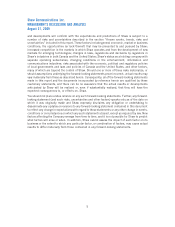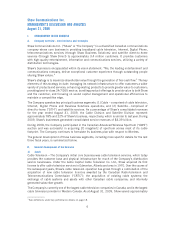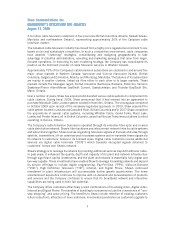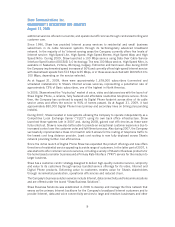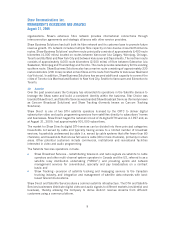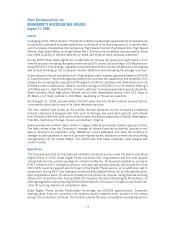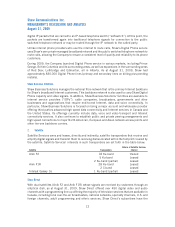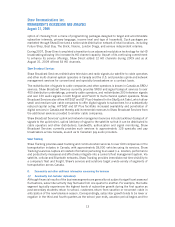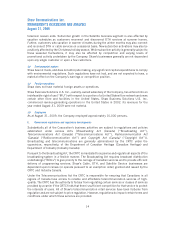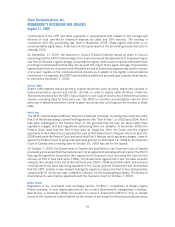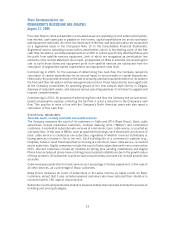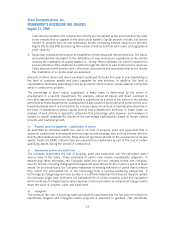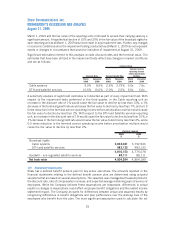Shaw 2009 Annual Report Download - page 19
Download and view the complete annual report
Please find page 19 of the 2009 Shaw annual report below. You can navigate through the pages in the report by either clicking on the pages listed below, or by using the keyword search tool below to find specific information within the annual report.The technical operating aspects of the Corporation’s businesses are also regulated by technical
requirements and performance standards established by Industry Canada, primarily under the
Telecommunications Act and the Radiocommunication Act.
Pursuant to the Copyright Act the Copyright Board of Canada oversees the collective administration
of copyright royalties in Canada including the review and approval of copyright tariff royalties
payable to copyright collectives by BDUs.
The sections below include a more detailed discussion of various regulatory matters and recent
developments specific to Shaw’s businesses.
Licensing and ownership
For each of its cable, DTH and SRDU undertakings, the Corporation holds a separate broadcasting
license or is exempt from licensing. The broadcasting licenses have generally been issued for terms
of up to seven years. In August 2008, the majority of the Corporation’s licensed cable undertakings
were renewed by the CRTC for a two-year period ending August 31, 2010. Shaw has filed renewal
applications for full-term, seven year license renewals. The licenses of the Corporation’s DTH and
SRDU undertakings are also valid until August 31, 2010. Shaw has never failed to obtain a licence
renewal for its cable, DTH or SRDU undertakings.
Rate regulation
All of the Corporation’s cable undertakings have been rate deregulated by the CRTC with respect to
the provision of basic cable service. Rates for the provision of basic service by all other types of
licensed and exempt systems, including the DTH undertaking, are not rate regulated. Fees charged
for the distribution of discretionary programming services have never been rate regulated.
Regulation with the potential for new or increased fees
Effective September 1, 2009, each licensed BDU is required to contribute 1.5% of its gross
revenues derived from Broadcasting to the Local Programming Improvement Fund (“LPIF”) to
support local television stations operating in non-metropolitan markets. The CRTC has indicated
that it will consider the appropriate long-term provisions for the LPIF. Exempt systems are not
required to contribute to LPIF.
In October 2008, the CRTC announced a change in its policy regarding the delivery of distant
signals by licensed BDUs. Under the new policy, licensed cable BDUs must obtain the consent of an
over-the-air broadcaster to deliver its signal in a distant market. DTH distribution undertakings can
distribute a local over-the-air television signal without consent within the province of origin, but
must obtain the permission to deliver the over-the-air television signal beyond the province of origin
unless the DTH distribution undertaking is required to carry the signal on its basic service. The
CRTC determined that broadcasters and licensed BDUs should negotiate the terms of distant
delivery but provided for arbitration where an agreement cannot be reached.
In July 2009 the CRTC initiated a proceeding (the scope of which was clarified in August 2009) that
is exploring, among other things, a group based approach to the licensing of television services and
other issues related to conventional television. As part of the proceeding, the CRTC is reviewing
certain aspects of the regulation of BDUs in connection with their distribution of over-the-air
television stations. The CRTC is considering implementing new revenue streams for over-the-air
television stations that could result in increased fees for BDU’s. Although the CRTC has stated it will
not introduce a “fee-for-carriage”, support measures could include a regime to negotiate
compensation for the value of local signals, protections for the integrity of local signals,
15
Shaw Communications Inc.
MANAGEMENT’S DISCUSSION AND ANALYSIS
August 31, 2009


